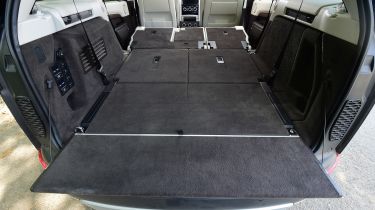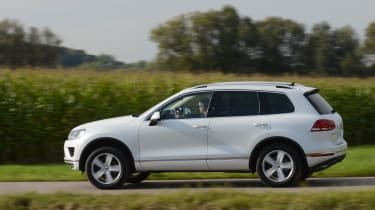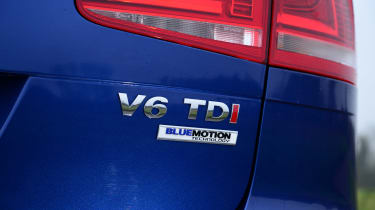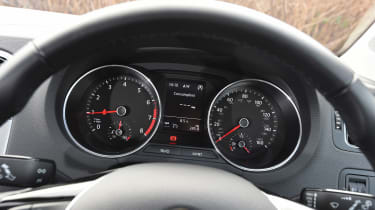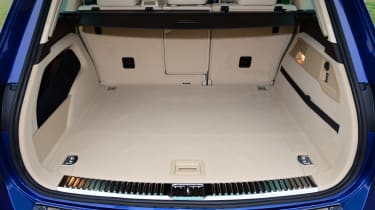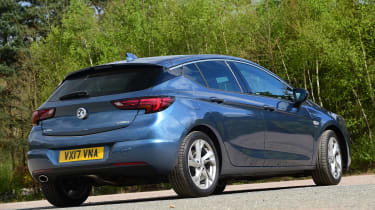Volkswagen Touareg (2014-2018) review
It’s a little long in the tooth, but the VW Touareg SUV offers plenty of space, refinement and luxury

The Volkswagen Touareg is a large premium SUV that’s a very close relative of the Porsche Cayenne and Audi Q7 models with which it shares a platform. As befits the VW brand values it’s a little less ostentatious – and less fun to drive – than both, but still offers plenty of space, luxury and performance.
It’s also considerably cheaper than the Audi and Porsche, but while the Touareg price list may look attractive against its VW Group stablemates, it has quite a fight on its hands when you look beyond them. First launched all the way back in 2002, the second generation VW Touareg for sale since 2010 must battle a significantly broader range of rivals that includes the Jeep Grand Cherokee, BMW X5, Land Rover Discovery Sport, Jaguar F-Pace and Mercedes GLE. A facelift in 2014 brought the Touareg styling into line with the rest of the VW family, but the model lacks some of the advanced tech of its more up-to-date premium rivals.
Aside from its age, and less than exciting driving dynamics, the Touareg suffers in the showroom as it isn’t offered with a seven-seat option, unlike many of its rivals. There’s also a lack of engine options, with the legendary Touareg V10 diesel now a distant memory as this second generation car only gets a single 3.0 V6 diesel engine. There is a choice of two power outputs, however, but all models share the same four-wheel drivetrain, and an eight-speed automatic gearbox.
There are three versions available, and the line-up starts with the Touareg SE. Its spec highlights include 19-inch alloys, leather upholstery, start-stop, parking sensors and an RNS 850 touchscreen nav system. Move up to the Touareg R-Line for sportier bumpers, side skirts, a panoramic roof, 20-inch wheels and keyless entry. The range-topping R-Line Plus rides on 21-inch alloys, and has surround-view cameras and plusher trim.
Used - available now

2023 Volkswagen
Touareg
60,297 milesAutomaticDiesel3.0L
Cash £24,887
2023 Volkswagen
Touareg
8,500 milesAutomaticDiesel3.0L
Cash £52,138
2023 Volkswagen
Touareg
37,223 milesAutomaticDiesel3.0L
Cash £42,590
2023 Volkswagen
Touareg
30,318 milesAutomaticDiesel3.0L
Cash £40,087Premium modern SUVs are fun to drive and this where the current Touareg shows its age, as Volkswagen’s biggest SUV isn’t very sporty. So if you’re still keen on the Touareg, it's best considering it as a workhorse - although a hugely comfortable, and luxurious one.
In that sense, the closest rival to the Touareg is probably the latest sharp-looking and refined Lexus RX. The VW has the edge in terms of quality and off-road ability, but the Lexus comes back hard with its low running costs and level of standard kit.
That Volkswagen badge and the associated image, goes some way to explaining why this car has an advantage over most of its rivals, though. It seems that despite the ongoing fallout surrounding Volkswagen diesel engines, the Touareg doesn’t attract the same disapproving looks as you’d get if you were driving a big 4x4 from Audi, BMW or Porsche, for example. So, this is a big, capable car that will pass under the radar, to an extent.
The Volkswagen Touareg appears conspicuously good value for money when you consider that it uses the same mechanical package as the vastly more expensive Porsche Cayenne, as well as the recently replaced original Audi Q7.
The lack of a seven-seat option holds it back though, and the cabin doesn’t look expensive enough for the price tag.
Engines, performance and drive
For such a big car, the Volkswagen Touareg handles well. It doesn’t have the sharpness of its Porsche Cayenne cousin, but it’s still pleasant to drive and very comfortable, too. You’ll find there’s plenty of body roll even when taking corners gently, but settle into the Touareg’s ways and it won’t let you down. Grip levels are prodigious, so it’ll hang on to the tarmac.
Buyers can specify air-suspension as an option – it costs between around £2,000 and £2,500 depending on whether you’re upgrading an R-Line or an SE model. The set-up sharpens the handling in corners and makes the ride genuinely plush. Plus, it’s worth considering if you’re serious about your off-roading (something the Touareg is surprisingly good at), as the air-suspension allows you to increase the ride height by 300mm for tackling serious terrain.
The car is also capable away from the beaten track. It comes equipped with low-ratio gears and hill descent control to aid off-road ability, although ultimately the limited ground clearance and slightly less impressive approach and departure angles hamper its performance over rough terrain when compared to a Land Rover Discovery or Jeep Grand Cherokee.
Engines
Buyers have only one engine to choose from in the Volkswagen Touareg, and it's the same excellent 3.0-litre V6 TDI diesel you’ll find in various Audis, as well as other VW Group models.
Recent revisions have raised power to 201bhp in the basic SE and R-Line models or a significantly more useful 258bhp in the Escape version. That more powerful engine is available as an option in the SE and R-Line trims.
Even the 258bhp diesel may sound as if it’s going to struggle in an off-roader weighing nearly 2.2 tonnes, but the massive 580Nm torque output should provide plenty of reassurance. Go for the lower-powered model and you still get an impressive 450Nm, which should be sufficient in-gear punch for overtaking on the motorway or pulling up a steep, muddy bank off-road.
Whichever version you choose, power is sent to all four wheels through an eight-speed Tiptronic automatic gearbox, and while that shifts cleanly and smoothly, the engine can be a bit too noisy at times. It’s not an aggressive diesel clatter; it’s more of a smooth, low-pitched rumble that really makes its presence known when you want more power. Still, the engine settles down once you’re up to cruising speed, and the Touareg is a refined motorway car.
MPG, CO2 and Running Costs
All versions of the Touareg wear the BlueMotion Technology badge, so in theory this big, hefty SUV benefits from the same kind of eco features that allow a Volkswagen Passat BlueMotion to claim 65mpg fuel economy. These include low-rolling-resistance tyres, a stop/start system and a coasting function for the automatic gearbox.
Certainly the latest model is a bit greener than the original Touareg was: the cleanest 201bhp model emits 173g/km of CO2, while the output is only 1g/km higher for the sportier 258bhp SE or R-Line versions. Officially, Volkswagen says that owners can achieve as much as 42.8mpg fuel economy out of the engine, but you'll be lucky to do better than 30mpg in the real world, and if most of your driving is around town your average returns will be closer to 25mpg.
Insurance groups
It's no great surprise that the lowest insurance premiums in the Touareg range are likely to be for the 201bhp model; in its most basic form, this version sits in insurance group 40. But if you go for the 57bhp more powerful car, it shouldn't make a massive difference to the cost of your annual policy. Touaregs equipped with the more powerful 3.0-litre V6 TDI diesel are rated only three groups higher, in group 43.
Depreciation
While the Touareg carries a lower price tag in showrooms than the likes of the Porsche Cayenne, BMW X5 and Range Rover Sport, potential buyers should bear in mind that it's not likely to hold on to its value as well as those rivals. Our experts predict that the car will retain around 50 percent of its new price after three years - which isn't a bad return for a big SUV come resale time - but alongside its prestige brand competitors, the Volkswagen is left trailing.
Interior, design and technology
As you'd expect from Volkswagen these days, the cabin of the Touareg is classy and beautifully made. The doors close with a reassuringly solid clunk and the seats are big, broad and hugely comfortable. All the basics are right too, from the clear instrument dials and neatly arranged switchgear to the widely adjustable driving position.
The thing is, the interior just doesn't look as expensive as that of the original 2002 Touareg. That model shared most of its design inside with the hugely expensive Volkswagen Phaeton saloon (which later turned out to be a massive sales flop) and that meant lashings of fake wood and impeccable build quality.
In contrast, the current Touareg looks and feels more like an upmarket version of the Passat. There's nothing wrong with that, as the large family car has a class-leading interior, and if you've never sat in a Mk1 model you won't know what you're missing. But we can't help feeling a bit let down - although Volkswagen has at least tried to add a bit more of a premium feel inside with its latest round of updates, and the Mk2 Touareg now seems more worthy of its price tag inside than it did when it was first launched.
Sat-nav, stereo and infotainment
A big, bright, eight-inch touchscreen takes pride of place in the centre of the Touareg's dashboard. But while it's simple enough to use, there's no getting away from the fact that it's a generation behind the one you'd get in a Volkswagen Golf - a car that costs a fraction of the price.
By way of compensation, the system features a 60GB hard drive pre-loaded with 3D sat-nav, and incorporates an SD card reader. It also includes Bluetooth connectivity, allowing you to make hands-free calls and stream music wirelessly from your smartphone. Plus, drivers and passengers can hook up their mobile to the system using the USB connection under the armrest. In addition to the touchscreen operation, there are steering wheel controls for the infotainment system.
Practicality, comfort and boot space
Not many cars can match the Volkswagen Touareg for comfort. Its seats are supremely supportive and on a long journey, the car is probably only beaten by a Volvo XC90 in this respect. This makes the Touareg a great choice for drivers who regularly spend hours behind the wheel.
Size
For a big SUV, this Volkswagen isn't that long - a 4,801mm, it's significantly shorter than some luxury saloons. The Touareg should have few problems with height restrictions at car parks too, as it's just 1,733mm tall.
But some drivers may have trouble getting used to its width - it measures 1,940mm wide, or 2,208mm including the mirrors. That's exacerbated by the driving position, which places you low down and towards the centre of the car, making the Touareg feel even bigger than it is when manouevring in tight spaces. A Land Rover Discovery has similar dimensions, but you just don't feel it from behind the wheel because its sight lines are so much better.
Leg room, head room & passenger space
You'll forgive the bulky feel inside the Touareg when driving around town because it's a very, very spacious car. Even on models with the optional sunroof, there's masses of headroom, while six-footers can stretch out comfortably in the back behind drivers or front seat passengers of a similar height. The car's considerable width also means you should be able to get three child safety seats side-by-side on the rear bench, which partly makes up for the lack of a seven-seat option.
Boot
The boot is massive no matter how you look at it, but you can adjust it to maximise rear passenger comfort or maximise luggage capacity. The rear seatbacks can be reclined, so boot space effectively expands from 580 litres to 679 litres.
Either way, that should be more than enough space, but of course you can fold the back seats to take really big loads. There's a handy lever in the boot to release the seats and once they're folded the luggage capacity increases to 1,642 litres. That's not as much as in a Land Rover Discovery - which can swallow up to a massive 2,558 litres - but it should be plenty for most people's needs.
Towing
The Volkswagen Touareg is an excellent car to use for towing all sorts of trailers. The towing capacity equals that of the impressive Land Rover Discovery, at 3,500kg, thanks to the powerful V6 diesel under the bonnet. There's also a handy lever in the boot to release the optional rear tow hitch.
Reliability and Safety
Volkswagen has an enviable reputation for quality and reliability, and as the Touareg is one of the brand’s flagship models, you’d like to think it gets that little bit of extra attention on the production line.
The big SUV didn’t feature in the Auto Express Driver 2015 satisfaction survey, as there weren’t enough responses from owners, but the general impression from drivers is that the Touareg is solid and dependable. It was well known in the trade that many Mk1 V10 TDIs ended up with suspension and underbody damage as Volkswagen didn’t fit strong enough brakes to cope with the extra weight of that mighty engine – owners were forced to go straight over grassy roundabouts. There are no such worries with the latest car, but it goes to show that you have to keep your eyes open.
On the safety front, the Touareg should provide exceptional crash protection. It hasn’t been tested independently by Euro NCAP, but the US Insurance Institute for Highway Safety gave the car the top ‘Good’ rating in all its assessments, which should give some peace of mind.
Plus, Volkswagen has fitted the Touareg with a full range of crash-avoidance systems, such as post-collision braking (which brings the car to a stop after an impact), stability control with a trailer-assist function and all-round airbags, including curtain airbags front and rear.
Buyers can specify more safety kit from the options list: active cruise control, lane departure warning, collision alert, city emergency braking and a blind-spot monitor are all available. So is a pre-crash sense system that tightens the seatbelts and closes the windows if it detects an unavoidable accident is imminent. Plus, all-round cameras help you park in tight spaces.
Deals
View the latest VW Touareg deals on our Find a Car service.
Warranty
The standard warranty covers the Touareg for three years and 60,000 miles, but buyers can upgrade that to four years and 75,000 miles for £690 or five years and 90,000 miles for a whopping £1,690. Volkswagen’s own in-house roadside assistance package comes as standard for three years.
Servicing
As with most major manufacturers these days, Volkswagen offers a fixed-price maintenance plan. Service intervals on the Touareg stand at 12 months or 10,000 miles for an oil change, 24 months and 20,000 miles for an interval service and oil change and 36 months and 30,000 miles for an inspection service with oil and brake fluid change.
More reviews
Car group tests
In-depth reviews
Long-term tests
Road tests
Which Is Best
Most Economical
- Name3.0 TSI eHybrid 4Motion Elegance 5dr Tip Auto
- Gearbox typeSemi-auto
- RRP£71,850
